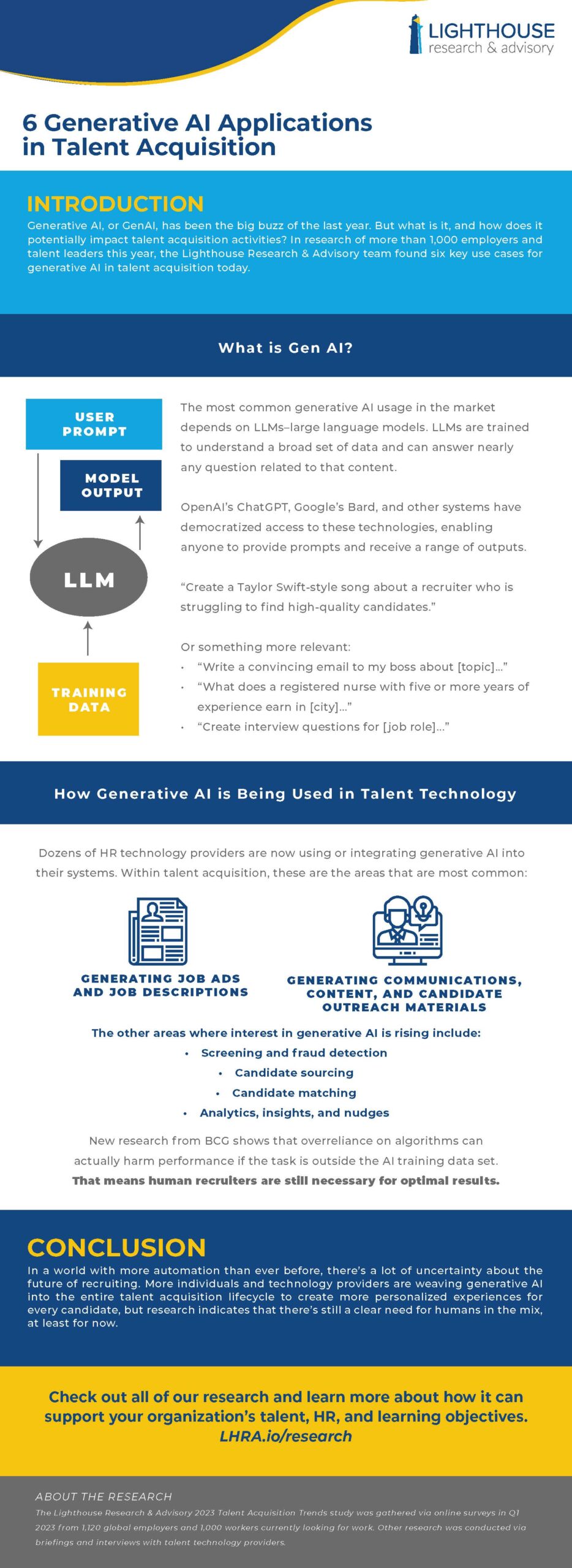6+ Generative AI Applications in Talent Acquisition Today [Infographic]
Generative AI. It’s the topic in what seems like every conference agenda, presentation, and headline today. But so much of it is focused on things like ChatGPT and Google’s Gemini (formerly Google Bard). However, there are a few “flavors” of generative AI being used by talent acquisition and HR teams today:
- Off-the-shelf public systems like ChatGPT that are trained on large language models (LLMs) from the broader Internet. These systems can be used by anyone, anywhere to brainstorm, speed up tasks, and generate new content. Pro: cheap/free to access. Con: overly broad.
- Native generative AI features built directly into HR technology that leverage proprietary or more narrow large language models specific to HR and talent. The seeming advantage of a narrower model to train the AI is that the results are richer and more targeted.
- A third sort of hybrid approach: HR tech firms can integrate with OpenAI’s ChatGPT (or other LLMs) and use that to power their queries and requests, bringing the answers right back into their HR tech interface. This is faster to develop and deploy, but it’s also broader and more general in nature.
In one of my most popular LinkedIn posts of the last year, I shared about some of the key areas that GenAI is being used in talent acquisition, including some of the technology companies that have developed these tools. That can be accessed here and is embedded directly into the post below. In addition, we have also developed an infographic that highlights these areas for easier sharing, and that is featured at the bottom of this post.
If your organization is looking to leverage generative AI to save time, increase candidate experience, or drive other hiring outcomes, we’d love to help you understand more about that. If your organization is creating hiring technology that stands out from the rest (we’ve seen some incredible things lately from firms like HollyHires.ai and Nebula.io), we work with HR technology providers to help them build and sell compelling solutions to today’s talent challenges.
In the infographic below, we have pulled these key areas together and highlight some of the ways that HR and talent leaders can use them to support everyday tasks across their teams.

Ben Eubanks is the Chief Research Officer at Lighthouse Research & Advisory. He is an author, speaker, and researcher with a passion for telling stories and making complex topics easy to understand.
His latest book Talent Scarcity answers the question every business leader has asked in recent years: “Where are all the people, and how do we get them back to work?” It shares practical and strategic recruiting and retention ideas and case studies for every employer.
His first book, Artificial Intelligence for HR, is the world’s most-cited resource on AI applications for hiring, development, and employee experience.
Ben has more than 10 years of experience both as an HR/recruiting executive as well as a researcher on workplace topics. His work is practical, relevant, and valued by practitioners from F100 firms to SMB organizations across the globe.
He has spoken to tens of thousands of HR professionals across the globe and enjoys sharing about technology, talent practices, and more. His speaking credits include the SHRM Annual Conference, Seminarium International, PeopleMatters Dubai and India, and over 100 other notable events.

